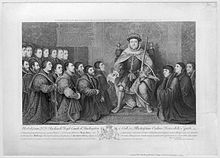- Worshipful Company of Barbers
-
 Henry VIII presents the Barber-Surgeons Charter to Thomas Vicary.1736 engraving by Bernard Baron (1736); after Hans Holbein the Younger.
Henry VIII presents the Barber-Surgeons Charter to Thomas Vicary.1736 engraving by Bernard Baron (1736); after Hans Holbein the Younger.
The Worshipful Company of Barbers is one of the Livery Companies of the City of London. The organisation's records date as early as 1308, recording Richard le Barber as the first to hold the office of Master.
Barbers aided monks, who were at the time the traditional practitioners of medicine and surgery, for Papal decrees had prohibited the members of religious orders from spilling blood. Soon surgeons with little expertise in the art of the barbers began to join the Company.
In 1368, the Surgeons were allowed to form their own Guild. However, the Barbers' Guild retained the power to oversee surgical practices. The Barbers' Guild continued its oversight after it became, under a Royal Charter of 1462, a Company. The Surgeon's Guild merged with the Barbers' Company in 1540 to form the Company of Barber-Surgeons. Their first master was the superintendent of St Bartholomew's Hospital and royal physician, Thomas Vicary. The presentation of the charter is the subject of a painting by Hans Holbein the Younger, in the collection of the National Portrait Gallery.
In 1745 the surgeons broke away from the barbers to form the Company of Surgeons becoming the Royal College of Surgeons in 1800. This historical relationship is also demonstrated by the fact that the Company's Hall is still called "Barber-Surgeons' Hall", long after the change in Company name. The Hall is located in Monkwell Square in Aldersgate ward, within the precincts of the Barbican estate.
The Company no longer retains an association with the hairdressing profession. It does however retain its links with surgery, principally acting as a charitable institution to the benefit of medical and surgical causes. Around 30% of the Company's liverymen are surgeons or other medical practitioners.
The Barbers' Company ranks seventeenth in the order of precedence of Livery Companies. The Company's motto is De Praescientia Dei, Latin for From the Foreknowledge of God.
Barber's Hall
The Barber's Hall was established in Monkwell Street in the 14th century. The hall survived the Great Fire of London; but was destroyed by enemy bombing in the London Blitz. The modern hall was rebuilt approximately 30 ft to the east of the former site.
After the licensing of dissection in 1540; public demonstrations took place four times a year in the Great Hall of Barber's Hall — with a crowd surrounding a table. Attendance was compulsory for all 'free' surgeons. By 1568, the 'Court of Assistants' of the Guild ordered wooden raised seating to be erected in the Hall during anatomies. By the 17th century, travellers noted that the universities at Padua and Leiden possessed purpose–built anatomical theatres. Inigo Jones was commissioned to design and build one for the Surgeon-Barbers, but died (1652) before it was finished. The work was completed by John Webb in 1636, but this theatre was destroyed by the Great Fire (1666).[1] It was rebuilt to the design of Christopher Wren, but demolished in 1740, when the Surgeons transferred their work to the Royal College. The dissected corpses were buried in the churchyard of St Olave's, Silver Street.
References
- ^ The Dissertation: An Architecture Student's Handbook Iain Borden, Katerina Ruedi Ray, Katerina Rüedi pp. 92–97(Architectural Press, 2005) ISBN 0750668253
External links
- The Barbers' Company
- Barber Surgeons’ Hall Gardens, London Wall (MOLAS) archeological survey March 1997
Categories:- Livery companies
- Barbican Estate
- 14th-century establishments in England
Wikimedia Foundation. 2010.

